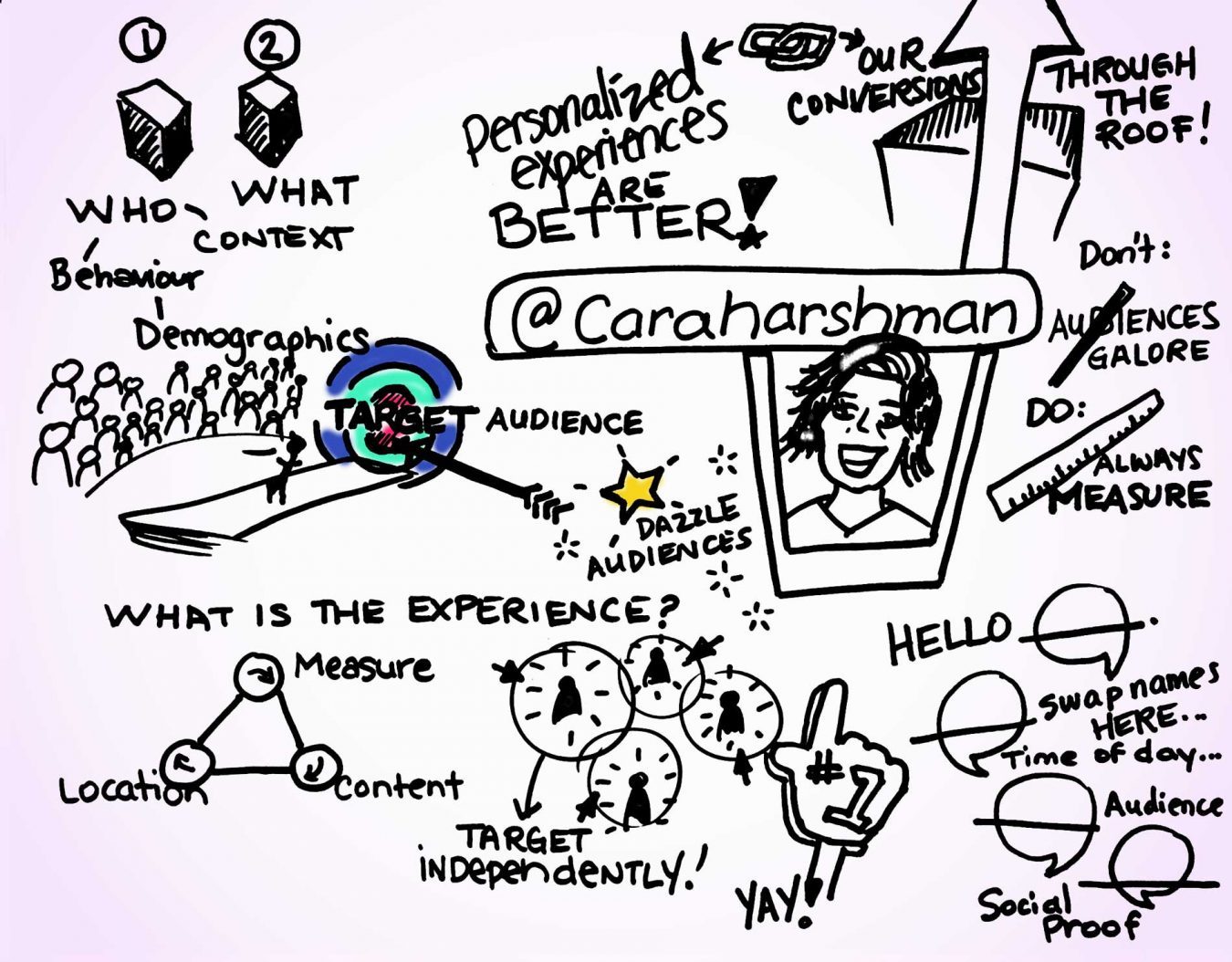InboundCon 2016 Decks & Notes
Last updated: October 11th, 2016

Thank you to all that attended InboundCon 2016. It was a huge success and we couldn’t have done it without all attendees, speakers and the amazing Powered by Search team.
Below are the notes we took on each speaker’s talk + their decks for InboundCon 2016.
Lots of love went into compiling these epic notes for you, so you might want to bookmark this page now because our guess is you’ll need to revisit it many times. The most important thing you can do is find opportunities where you can take action on some of these amazing tips provided at the conference.
Here are some additional fun ways you can engage with the InboundCon Notes:
- Read this page slowly and luxuriously over a cup of coffee.
- Grab your notebook and create a list of action-items. Add deadlines.
- Google the speakers. Tweet them. Email them. Read their books.
- Write a blog post for your website about this event.
- Share this information socially. (your friends will thank you later!)
- Find your million dollar idea.
Can’t wait to see you next year. 🙂
Table of Contents:
Dev Basu – The Preeminence Mindset
April Dunford – Using Modern Positioning to Dominate Your Market and Kick-start Your Growth
Kimbe MacMaster – The Best-Kept Secrets to Turning Viewers into Customers (faster!) with Video
Matthew Hunt – How My Addiction to Self-help Books, My Acting Career, My Children, My Office Door, My Accountant, & My Dyslexia Have Taught Me Everything I Need to Know to Make Online Paid Advertising Campaigns 10 Times Better!
Wil Reynolds – The Modern SEO’s Approach to Winning with Google and People
Jeff Goldenberg – 10 Tricks to Growth Hack your Email Marketing
Cara Harshman – How to Use The Building Blocks of Website Personalization To Unlock More Sales
Chris Stolz – How to Astound Your Audience With Your Website That It Will Keep Your Customers Coming Back For More!
Mark Sullivan – From Toxic Mold to Google Analytics: How to Create Meaningful Reports
Myles Anderson – Leveraging Your Reputation to Drive More Clicks & Calls
Michael Aagaard – You’re Making My Brain Hurt! The Psychology Behind Terrible Conversion Experiences
Dev Basu – The Preeminence Mindset
Take Action: Fall in love with your audience. Serve them.
We as marketers have stopped serving and started selling, using too much “big data” and magic tactics. Brands are not keeping their promises, so consumers are actively unfollowing brands. Yet, when it comes to trust, most of the work is done before you even enter the room.
The problem: We have fallen more in love with ourselves than the people we serve.
It’s time to ask ourselves what benefit we need to give to earn business. Because when you focus on value, the concept of “price” goes out the window — it becomes irrelevant. When you inspire those that you serve, you can turn a NO into a YES — that is the mindset of preeminence.
Problem #1: Just because you see a problem doesn’t mean you know how to solve it.
Problem #2: Just because they know their orientation doesn’t mean they know what they want. Your purpose as a marketer is to provide focus.
Problem #3: Just because they’re clear on what they want doesn’t mean they feel like you “get them.” Who was the last person who had your back? How did they make you feel?
Problem #4: Without trust, people won’t take action.
Focus → Clarity → Power → Understanding → Certainty → Trust → Action
“I will fall more in love with my audience than with myself.”

April Dunford – Using Modern Positioning to Dominate Your Market and Kick-start Your Growth

Take Action: Position yourself intentionally based on what makes you special.
Even a world-renowned violinist can be unappreciated in the setting of NYC subway station. It’s not just that the audience was busy… but the artist was sabotaged by his context. If you put the product in the wrong context, people can’t figure it out. And despite this common dilemma, we rarely set context deliberately.
Don’t use cookie-cutter templates for giving context to your audience. You can write crap down, but it’s still crap.
The 4 Styles of Positioning
1. Arm wrestling: Be stronger than the leader in your category. Risk: you need time & money.
2. Big Fish, Smaller Pond: Be the leader in a sub-sector of an existing market. Risk: The leader matches your offering.
3. Reframe the Market: Through innovation, teach people that the way they frame the market is wrong. Risk: the leader positions your innovation as a feature.
4. Change the Game: Invent a new market. Risk: Adjacent category leaders try to subsume your category / fast followers beat you before you are established as leader.
Find out who you are and do it on purpose.

Kimbe MacMaster – The Best-Kept Secrets to Turning Viewers into Customers (faster!) with Video

Take Action: Create videos to build relationships with your customers.
Successful long-term relationship = Attention + Nurturing + Trust
When we’re selling B2B, we’re still selling to people; appealing to emotion helps them buy. Including video in email campaigns is reduces email opt-out rate and engages the customer’s emotions.
Ways to use video for marketing:
1. Personalized video that includes specific personal information (e.g. name) like the University of Waterloo video. It pulls them into the experience, and click-through can increase by 2x to 5x.
Best practices: make sure the personalization is added to pre-production so it’s not a gimmick, include a screenshot of the video in the email, and include the word “video” in your email subject.
2. Interactive video such as lead-capture videos or videos with polls.
Best practices: don’t ask for information without giving value, don’t interrupt the experience (unless it’s worth it for them), and don’t ask for their info every video (rude).
3. Build more trust with live streaming like company events, new products, or Q&A.
You can’t fake it. It’s authentic.
Best practices: set a goal and track it, establish urgency or exclusivity, and don’t sweat the production.

Matthew Hunt – How My Addiction to Self-help Books, My Acting Career, My Children, My Office Door, My Accountant, & My Dyslexia Have Taught Me Everything I Need to Know to Make Online Paid Advertising Campaigns 10 Times Better!

Take Action: Use your competitors to learn what ad creative works, then appeal to a short attention span. Create a unique and intuitive experience for each buyer journey.
Digital has 46% of our attention, but only about 20% of marketers budgets. Stay with the times! Today, the average life expectancy for a Fortune 500 Company is only 15 years.
1. Self-help books: Success leaves clues.
Spy on your competitors. Learn what they’re spending, learn what they’re saying, learn what keywords they’re competing on.
2. My acting career: Know who your heroes are (your customers). Give them each a unique experience. Tell a great story.
Learn about your hero using data and insights. What motivates your hero? What pain will get worse if they don’t solve their problem? Then create a marketing funnel for each unique hero.
3. My Kids: Attention spans are short. Your ads need to appeal to their attention span. Appeal to curiosity to bait your customers. Avoid ad fatigue:
Who (audience) + Where + Desire & intent + Bait = Success
4. My office door: Be intuitive: don’t make your audience think. Match landing pages to your ad creative. Be crystal clear.
5. My accountant: Trim the fat. If you measure it, you can improve upon it.
Learn what 20% of your marketing efforts are generating 80% of your results. You cannot do this unless you are tracking.
6. My dyslexia: All businesses have blind spots. Slice your information into smaller pieces. Find ways to make it easier for your customers to get small values that will lead to your greater value.
Use a value ladder. For example, a dentist might use the following:
Free teeth cleaning → teeth whitening → night guard → cosmetic surgery

Wil Reynolds – The Modern SEO’s Approach to Winning with Google and People

Take Action: Think about humans: deliver content that solves the user’s problems and delivers what they are actually looking for.
Search is not linear. It’s actually a complex system with lot of steps. Google doesn’t buy your shit. People do. Understand how people go from click to buying.
Build trust with your customers:
Provide Value: Because ultimately marketing amplifies; it doesn’t fix a bad product.
Set Expectations: The brain reacts based on what it expects. It likes being able to predict what the experience is going to be like.
Brand Matters: When looking for products, people skip google and go to Amazon because they trust it right away. People will add “reddit” to review searches because they trust the brand. People look at forums like Quora.com to get more information about brands.
Go Where the People Are: Look for advertising opportunities on content that already ranks.
Complete Your Content: Answer the questions your customers actually have, or someone else will! Don’t build 10 different pages; build one comprehensive page that walks the user through the whole process.
Understand Intent: Why does my page not rank for my target keyword? It’s because it’s not delivering what the customers want.

Jeff Goldenberg – 10 Tricks to Growth Hack your Email Marketing

Take Action: It’s time to make changes to your email list. Start small and build them up.
Email is important! Do it right.
Always Be Collecting email addresses: CTA forms on everything.
Make it Personal: Plain text is fine. Keep it authentic if it’s an email.
Segment and Solve: Talk to different people with different problems in different ways. Segment your email lists, and solve their unique problem. Prove that you deserve their $.
Deliverability: Avoid words that trigger spam, and test small batches and headlines. Try subjectline.com. Focus on things that make a big difference. Pay attention to what time of day and what subject lines get the best results.
Click Through Rates: Have one simple call-to-action, and include social proof. Your call-to-action should be easy to understand and quick to act on.
Mobile First: Keep Google inbox in mind, and assume that’s how they read it. See how your email will look with a tool called Litmus.
Email Automation: Very easy, and very important for long sales cycles.
Strategy First: Know your objective and tools. Don’t be afraid to change or try new things.
Quick Wins: You look for them in Onboarding, ecommerce, content, and lead nurturing.
Testing: Run a challenger vs a champion in A-B testing. Look for outliers; follow them.
Don’t quit. Start with a small fire and build it up — it’s worth the effort.

Cara Harshman – How to Use The Building Blocks of Website Personalization To Unlock More Sales

Take Action: Increase conversions by delivering a better digital experience for your customers with personalization.
Customers expect great experiences and have no time for crappy ones. Personalize your website for your customer.
3 blocks to your audience:
Context: What is unique about the visitor right now?
E.g. referral source, device/browser, new or returning visitor, UTM source
Case study: Secret Escapes had a high click-through rate to their landing page, but low conversion rate. By personalizing the background image and some text, they increased their conversions by 32%
Behaviour: What is the visitor doing?
E.g. Downloaded content, viewed a page twice, abandoned a cart, read specific content category
Case study: Brooks Running wanted to decrease returns. People were ordering 2 different sizes of the same shoes to try them on. They responded with a personalized message to set up a fitting. This action decreased returns by 80% and increased conversions 2%.
Demographics: Who is the visitor?
Industry, location, gender, company size
Case study: Citrix Changed a default experience to a customized one for each verticles, ie. education. They saw a 30% increase in clicks.
Optimizely customized the homepage based on who was visiting, based on their vertical, or even the time of day.
Tips for designing the experience:
Location: Where on the page is the experience? Put circles on the things you can personalize.
Content: What is the message? Tailor your message based on their behavior and demographics. It’s better to leave it ad-lib style, so you only have to change small bits of the content.
Measure: How is it performing? People tweeted pictures of their homepage.1.5% increase in engagement, and a 113% increase in visits to solution page, and 117% increase in starts account
Tips to get it done:
→ Don’t create too many audiences
→ Treat these experiences as hypotheses
→ Do it because it’s valuable, not because you can. Otherwise, it is creepy.

Chris Stolz – How to Astound Your Audience With Your Website That It Will Keep Your Customers Coming Back For More!
Take Action: Pass the “So what?” test. Don’t meet expectations; take a risk and crush it.
Stop making shitty ads.
You’ll never stand out if you don’t try. Compare your website to everything. Not just competitors, but the constant influx of messages your customers receive on a daily basis.
Astounding your audience ≠ delighting your audience
Delightful experience will make you smile. An astounding experience will make you take a hundred pictures and tell everyone you know.
How to astound your audience:
- Make it fun or funny: like the Old Spice Man, which was just an effort to rejuvenate a stuffy brand. Or the George Bush audiobook ad, which made fun of the president.
- Make it easier than anyone ever has, ever: like when the printer ink company took the data they already had to make the customers lives easier. Or when Amazon created the one-click checkout. Demonstrate that you’ll do the work for them.
- Give them something they really, really want: like Kickstarter. Kickstarter is a great place to find out where people will pay money just to make sure something exists.
- Call out the status quo and then crush it: like Google photos, reminding users of the crappy experience of not having enough storage.
- Surprise or shock them: like a button that says “Don’t Click” and leads to a page that explains they understand user behaviour.
Note: good copy comes from listening to the emotions of existing leads.
Mark Sullivan – From Toxic Mold to Google Analytics: How to Create Meaningful Reports
Take Action: Do not ship a report unless it can inform decisions and inspire confident action.
When reports are not meaningful there is no action.
Meaningful reports:
- Empower & inform decision making
- Inspire confidence in taking action
Reporting is going to get harder over time, with more tools to choose from and more KPIs.
Weak reporting has:
- Poor choices of data
- Poor display of data
- Missing data
Great reporting has
- Effective choices of data
- Effective display of data
- Complete data
Follow the three ake your reports better:
- Choose right data: You may not know you have the wrong data until you have a lot of it. Short of revenue data, first-time callers is probably the #1 metric you can use to measure the success of a new business.
- Choose the right display: Display your data in a way that creates a narrative. What’s the shift? How has the market changed as a result of the data? Note: if your reporting is too busy, you’re better off having less data.
- Always err on the side of simplicity. Because a simple report can be acted on.
- Include all relevant context: If you see something that looks out of place, you need to know what’s actually going on. Use annotations when you are using analytics.
Always ask yourself, “Does this report help my audience make a decision?”
Myles Anderson – Leveraging Your Reputation to Drive More Clicks & Calls
Take Action: Reviews should be deeply integrated in your business plan.
Leverage, promote, amplify, and exploit your reputation.
The power of reputation is not confined to search; you can use it on your website, in social media, email marketing, offline marketing, and sales materials.
Stats:
→ 91% of consumers read reviews for local businesses
→ 84% of consumers trust reviews
→ 68% say good reviews help them trust a business
→ Star rating is the top factor in purchase decision
→ CTR only increased above 3 stars
→ positive reviews increased landing page trust by 11% and contact by 6%.
6 Pillars of Effective Review Strategy:
- Set Clear Targets: You need enough reviews to convince a customer to trust you. You can’t have too many reviews, but there is a natural diminishing return. In setting targets, think about the freshness of reviews as well, not a quota.
- 73% of consumers feel that reviews older than 3 months are irrelevant. You need monthly targets.
- Ask customers to write you a review: It should be baked into your sales process. Always ask for a review. Ask when customer satisfaction is highest. Don’t let them forget how excited they were.
- Use Only a Few Sites: Build reviews on a few key sites. Using too many will dilute your reviews. Consider where you already have reviews and the type of audience.
- Don’t ignore negative reviews: Your consumers will read negative reviews. You should reduce the impact by getting more positive reviews and by also responding to the negative ones positively and publicly. Turn a negative situation into a positive one, and NEVER attack the reviewer.
- Educate and Incentivise Staff: Make it easier to understand. E.g. “more reviews = more business = more job security.” Also make the reviews more worth their while with career progression.
- Leveraging Reputation: Use twitter, email marketing, or other reputation aspects into marketing.
Michael Aagaard – You’re Making My Brain Hurt! The Psychology Behind Terrible Conversion Experiences
Take Action: Switch from thinking like a marketer to thinking like your audience.
There are two fundamentally different modes of thinking:
- System 1: Intuitive (something that happens to you easily)
- System 2: Analytical (something that requires effort on your part)
The difference between System 1 and System 2 thinking isn’t a reflection on how intelligent we are — it’s just that System 1 is much faster. System 2 is lazy.
The Law of Least Effort: If human beings are presented with an easy option and a hard option to get from point A to point B, we’ll likely choose the easiest route.
Attention Ratio: How many things can you do vs. How many things you should do? Responsive design does not guarantee good user experience. If there are too many options, the user will be confused.
The goal is to create a conversion experience that facilitates cognitive ease, and limits use of System 2. You can learn where the system is broken by doing a “funnel walk through” and ask yourself, “Where in my funnel flow does it hurt?”
Also try performing 5-second tests to tap into System 1 — what is their intuitive reaction to your landing page?
Cognitive biases
- Bias #1 — Priming: You can prime someone by first exposing them to the idea you want them to understand. It doesn’t take much to effectively influence this process.
- Bias #2 — Framing: The way you frame something has a direct impact on how it’s perceived. It takes very little to frame something in such a way that people believe something that isn’t true.
The way you deliver a message has a direct impact on how it’s perceived. Interview your customers to understand what’s most important to them.
Delightful experiences only occur when the marketers (mostly system 2) cross over into thinking like the audience (system 1).
Did we miss any notes and important points?
What were some gems you felt we missed? Add those points and your ideas below as a comment. Let’s all contribute our favorite parts about this year’s InboundCon below and we’ll make this the most amazing reference document for this event and for all attendees.
Thank-you again to all those that attended!
What you should do now
Whenever you’re ready…here are 4 ways we can help you grow your B2B software or technology business:
- Claim your Free Marketing Plan. If you’d like to work with us to turn your website into your best demo and trial acquisition platform, claim your FREE Marketing Plan. One of our growth experts will understand your current demand generation situation, and then suggest practical digital marketing strategies to hit your pipeline targets with certainty and predictability.
- If you’d like to learn the exact demand strategies we use for free, go to our blog or visit our resources section, where you can download guides, calculators, and templates we use for our most successful clients.
- If you’d like to work with other experts on our team or learn why we have off the charts team member satisfaction score, then see our Careers page.
- If you know another marketer who’d enjoy reading this page, share it with them via email, Linkedin, Twitter, or Facebook.